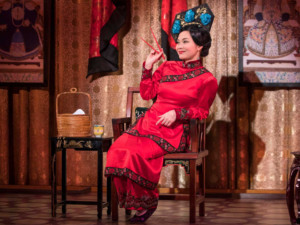Review: Spellbinding CHINESE LADY Gives Voice to Lost History at The Milwaukee Rep

Curiosity is part of our humanity. It is also "human nature to forget," writes playwright Lloyd Suh. Thanks to the Milwaukee Repertory Theater's New Play Development Program, Suh's The Chinese Lady imparts an utterly unforgettable piece of theater, while also embedding the fascinating and extraordinarily troubling story of Afong Moy into hearts and minds.
Who is Afong Moy? In 1834, she was brought from Beijing to America at the tender age of 14 to 16 (historians aren't sure) to be put on display as "The Chinese Lady." Until that point, Chinese immigrants to the U.S. were strictly male laborers, so it's true that Afong Moy may well have been the very first Chinese woman to set foot in New York.
The museum exhibit catered to New Yorkers' fascination with foreign traditions like foot binding, chopsticks, tea, and "Chinese curiosities." Silk trimmings, lanterns, and intricately-carved furniture filled the fabricated "authentic" room where Afong Moy would sit, day in and day out. Kudos to Scenic Designer Collette Pollard's ravishing vision for this Milwaukee Rep production: a larger-than-life painted box, which opens through a series of pulleys to reveal a cage masquerading as a finely-furnished space.
Don't mistake Afong Moy's history for performance art. She was essentially sold by her family to be objectified as a novelty, not understood as a human being. It was originally planned that Afong Moy would return to China after two years, but that's not how her life played out. The truth is, little is known of her life, yet that's just what The Chinese Lady endeavors to imagine.
In Suh's clever, riveting script, we see Afong Moy as she might have been at various stages of her life: Brimming with endless possibility and hope at age 14. Optimistically viewing her daily performance as a "great responsibility" to bridge cultures at age 16. Her sense of feeling "less and less Chinese" at age 17. Intense disillusionment with being a woman on display by age 29, and so on.
As Afong Moy, Lisa Helmi Johanson captivates, superbly embodying the shifts in her character's thoughts, feelings, and age. When youthful, Johanson delivers an Afong Moy who is adorably earnest and exceedingly curious about America and the people in it - people who wear shoes indoors, sleep three feet off the ground, and eat with forks. Her enthusiasm and trust of those in control of her fate is, of course, naive. As her translator Atung (the excellent Jon Norman Schneider) says, Afong Moy has "so much hope and so little reality."
This hope starts to crumble upon a meeting with President Andrew Jackson, a conversation enacted to squirm-inducing perfection by Schneider, the other half of this two-person play. President Jackson is the first to casually call Afong Moy a "freak show" to her face - a comment that, no wonder, changes the tone of The Chinese Lady. Johanson navigates this gradual awakening to reality with grace and poignancy, her performance and range nothing short of exquisite.
The play goes on to imagine Afong Moy growing old alongside other Chinese-American immigrants. While she has always been speaking directly to the Milwaukee Rep's Stiemke Studio audience in telling Afong Moy's own story, Johanson now dives into the broader history of Chinese-Americans in the late 1800s and early 1900s, submitting her captive audience to a much-needed refresher in the history of the atrocities European-Americans committed against the Chinese.
These were hope-filled people used as pawns to blast deadly holes in mountains for railroads - as Suh writes, "to execute a vision even as it executed them." In 1882, the Chinese people were smacked with the Chinese Exclusion Act, barring any Chinese immigration to the United States for 10 years. Then 10 more years. Then permanently instated in 1902, only to be repealed finally in 1943. It's a sad and sickening story, and one that demands retelling.
As Afong Moy reminds us in The Chinese Lady, the great task remains before us. That task is to never forget; to take the time to examine the past to inform the present and shape the future. Experiencing The Chinese Lady is a magnificently moving way to reacquaint ourselves with an uncomfortable, haunting part of our nation's history and be sucker-punched by how relevant Afong Moy's legacy is today.
Reader Reviews

Videos

